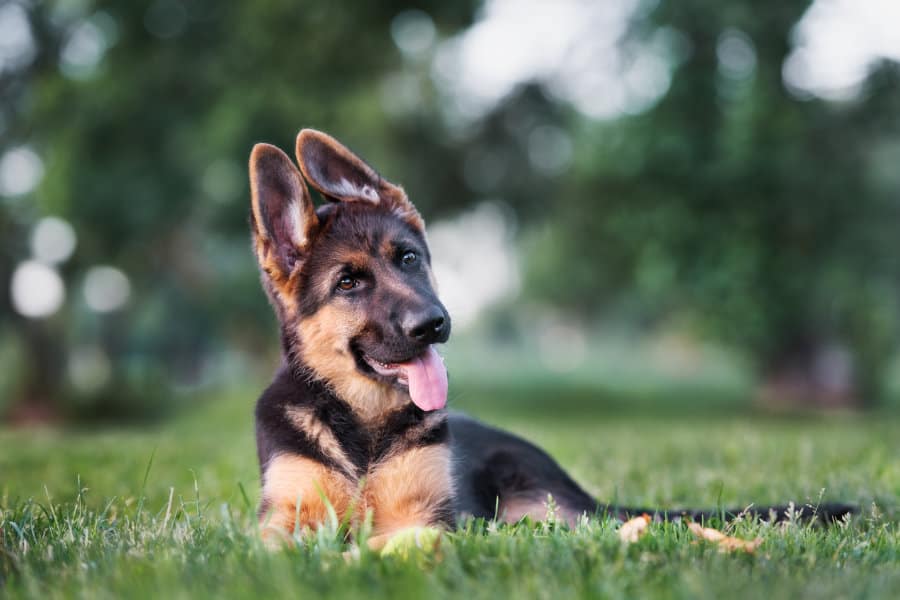When you think of a German Shepherd, you probably think of a powerful and protective dog with ears that stand straight up like a wolf. But a German Shepherd puppy’s ears don’t stand up right away. At what age do their ears begin to stand up?
German Shepherd’s ears usually stand up around five months old. After your puppy finishes teething, its ears should start to stand up or already be up. All puppies grow differently, so for some, it may take up to seven or eight months for your German Shepherd’s ears to completely develop.
This article will discuss why ear development is essential in German Shepherd puppies. Why pointy ears are necessary, why some dogs have floppy ears, and what to do if you want your dog’s ears to point, but they won’t stand up.

Is It Important That My German Shepherd Has Pointy Ears?
A German Shepherd’s pointy ears used to be required for hunting. When dogs are listening to something, you’ll notice their ears stand straight up. German Shepherds used their pointy ears to their advantage when hunting for food and protecting themselves.
Today, German Shepherds are a common breed of police dogs that need to be highly trained and on alert. Therefore, their ears come in handy while they’re working.
But is it important? Well, that depends on you.
If you want to train your German Shepherd to become a police dog, you must do everything you can to prepare them. Floppy ears on the police force might hinder your dog’s ability to perform as they should.
If you breed German Shepherds, pointy ears are essential, as they are a desirable trait to German Shepherd owners. Since you don’t know what potential buyers are looking for, you want to make sure your dogs are in tip-top shape.
However, if you have a German Shepherd simply because you love the breed, floppy ears aren’t something to worry about. Many people panic and think something is wrong with their dog, but floppy ears don’t cause any severe health risks to your dog.
If your German Shepherd’s ears do end up being floppy, be sure to clean them out, as dogs with floppy ears are more prone to getting ear infections.
What If My German Shepherd’s Ears Never Stand Up?
If your German Shepherd puppy is way past the teething stage and its ears show no sign of standing up, they might never do so. Your German Shepherd will most likely have partially floppy ears, as it’s extremely rare for them to be completely floppy.
As puppies, German Shepherds don’t have the strong cartilage that adult German Shepherds have. Over time, the soft cartilage will harden and usually stand up. However, if they don’t, there are several things you can do to encourage ear development.
Give Your German Shepherd The Proper Nutrients
Sometimes dog food just doesn’t cut it when it comes to nutrients, and a puppy needs to receive proper nutrients in order to develop and grow into a healthy adult dog.
To make sure your puppy is receiving the proper nutrients, WoofWell Health Supplements is well recommended, as it promotes healthy joints, vision, and immune support.
Giving your German Shepherd the nutrients it needs in its diet can be crucial in developing its ears. However, be careful with the amount of calcium you’re giving your puppy because too much calcium as a puppy can do more harm than good.
Encourage The Use Of Ear Muscles
Encourage your German Shepherd puppy to chew on toys, because this action will strengthen the muscles at the base of the ear. Buy a couple of new bones for your dog or some durable chew toys, and let your puppy play.
You can also make exciting sounds to try to get your puppy to perk its ears up. A squeaky toy or a whistle are both sounds that might encourage your German Shepherd to use those ear muscles.

Post Your Puppy’s Ears
Posting is a common practice used on German Shepherds. If your dog’s ears aren’t standing on their own by five months old, vets recommend that you post them before the cartilage in the ear has time to develop completely.
If you’re going to post your German Shepherd’s ears, this Osto-Bond Skin Bond Latex Adhesive, works well to help post your dog’s ears in an ear form. Before applying the adhesive, make sure you wipe the inside of your dog’s ears to remove any dirt or oil.
You can also use the taping method on your German Shepherd’s ears. To do this, take a rolled-up paper towel and line it with something straight, such as a ruler or pencil, stick it slightly into the ear, and use surgical tape to tape them together and hold them up.
There are many different ways to go about the taping process. You can use other materials as long as it’s not harmful to the dog but check with your vet first. This process is easy once you know what you’re doing, but vets can be a great asset if you’re having any trouble with taping the puppy’s ears.
Cropping
Cropping is a practice that is illegal in some places. However, it’s allowed anywhere in the United States, despite some states having restrictions. Cropping involves removing a portion of the pinnae, or the external flap of the ear.
Cropping is a practice still used today to preserve the breed. However, cosmetic purposes are usually the reason for doing it, so because of this, it’s a prevalent practice among dog shows.
Considering that ear cropping is banned around most of the world, it’s a declining practice. Many people don’t recommend going this route with your German Shepherd, but if you do, it’s vital to do so before they’re 16 weeks old. After 16 weeks, your dog has greater pain memory, making the procedure more painful on your pup.
Why Do Some Dogs Have Floppy Ears?
Dogs with floppy ears are a cute characteristic of many dogs today, but they’re just a defect due to domestication and breeding. German Shepherds look a lot like wolves with their ears standing straight up. Beagles, however, look nothing like their wolf ancestors with their smaller stature and big, floppy ears.
Charles Darwin discovered something called the Domestication Syndrome in many animals, dogs included. Dog ears are a trait that has been affected by domestication syndrome, which can explain why some breeds have floppy ears while others do not.
Darwin was very interested in domesticated dogs and how they differed from wolves. He found that domesticated dogs show behavioral, psychological, and morphological traits not observed in their wild forebears, which means that dogs changed physically, as well as their behavior and mental capacity.
Therefore, over time, some dogs lost their stick-straight ears, which became floppy. Domestication and breeding are both reasons why some dogs have floppy ears while others still develop pointy ears.
Final Thoughts
A German Shepherd’s ears will typically stand up on their own within five to eight months. All puppies are different and develop at their own pace. However, if your dog’s ears haven’t stood up by the eight-month mark, they most likely never will.
Encouraging ear development as a puppy by feeding your dog the proper nutrients it needs to develop, working the ear muscles, and even posting or taping the ears will increase the chances of your German Shepherd being a pointy-eared pup.
